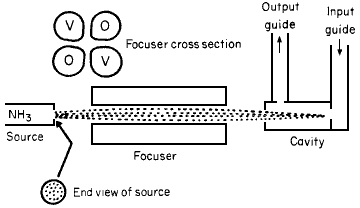MICROWAVE LASER

Beam of ammonia passes through an electrostatic focuser to
separate out molecules in the upper quantum state.
(Townes
and Shawlow, 1954)
Quantum Description
It is no coincidence that laser action was first produced in the microwave
region : Spontaneous emission is proportional to the cube of the transition
frequency, it is extremely small in this part of the spectrum
and can be neglected compared to other important processes such as stimulated
emission and absorption. Therefore population inversions are easily achieved with
very modest pumping powers. The first population inversion was achieved in
the ammonia molecule, which consists of a nitrogen at the apex of a pyramid of three
hydrogen atoms. The two lowest levels of ammonia are the result of inversion
splitting of the vibrational levels caused by a potential curve with a double minima.
Population inversion in ammonia is established by physical separation of molecules
in the upper quantum state from those in the lower quantum state.
Mechanical Description
 Physical separation was accomplished in the first microwave laser
(Townes,
et al. 1954) by projecting a beam of ammonia molecules through a system of focussing
electrodes which generate a quadrupolar cylindrical electrostatic field in the
direction of the beam. Molecules in the lower quantum state experience an
outward force and rapidly leave the beam, those in the upper quantum state see a
radial inward (focussing) force and eventually enter the cavity. When microwave
power of the appropriate resonant frequency (24 GigaHertz) is passed through the
cavity, amplification occurs due to the population inversion. If the output
power emitted is sufficiently large, self-sustained oscillations results and the
input beam is no longer required. When it is operating beyond this threshold the
internal losses are compensated by a large enough gain and the device behaves
like an oscillator. Below threshold it behaves like an amplifier.
Physical separation was accomplished in the first microwave laser
(Townes,
et al. 1954) by projecting a beam of ammonia molecules through a system of focussing
electrodes which generate a quadrupolar cylindrical electrostatic field in the
direction of the beam. Molecules in the lower quantum state experience an
outward force and rapidly leave the beam, those in the upper quantum state see a
radial inward (focussing) force and eventually enter the cavity. When microwave
power of the appropriate resonant frequency (24 GigaHertz) is passed through the
cavity, amplification occurs due to the population inversion. If the output
power emitted is sufficiently large, self-sustained oscillations results and the
input beam is no longer required. When it is operating beyond this threshold the
internal losses are compensated by a large enough gain and the device behaves
like an oscillator. Below threshold it behaves like an amplifier.
Practical Use
Some friends called the laboratory in which the
Townes
(1954) group had been working for two years on the device and tried to insist that Townes stop this
nonsense and wastage of government money, they had by then spent about $30,000
of the grant money. After the first successful operation of the microwave laser,
Townes, Gordon and some other students came up with the name M.A.S.E.R. :
Microwave Amplification by Stimulated Emission of Radiation.
(sceptics still made fun of them and read it as :
Means of Acquiring Support for Expensive Research !)
Townes, Basov and Prokhorov won the Nobel Prize in 1964 for their
work on both microwave and optical lasers.
 Charles H. Townes
Charles H. Townes
 Arthur L. Shawlow
Arthur L. Shawlow
REFERENCES
- Gordon,J.P., Zeiger,H.J.,
Townes,C.H.: 1954, Phys.Rev., 95, 282.
Masers amplifiers/oscillators
- 'Basic research is like shooting an arrow into the air and,
where it lands, painting a target.'
-Homer Adkins, Nature, 312, 212.
Laser History
 Charles H. Townes
Charles H. Townes
 Arthur L. Shawlow
Arthur L. Shawlow
 Physical separation was accomplished in the first microwave laser
(Townes,
et al. 1954) by projecting a beam of ammonia molecules through a system of focussing
electrodes which generate a quadrupolar cylindrical electrostatic field in the
direction of the beam. Molecules in the lower quantum state experience an
outward force and rapidly leave the beam, those in the upper quantum state see a
radial inward (focussing) force and eventually enter the cavity. When microwave
power of the appropriate resonant frequency (24 GigaHertz) is passed through the
cavity, amplification occurs due to the population inversion. If the output
power emitted is sufficiently large, self-sustained oscillations results and the
input beam is no longer required. When it is operating beyond this threshold the
internal losses are compensated by a large enough gain and the device behaves
like an oscillator. Below threshold it behaves like an amplifier.
Physical separation was accomplished in the first microwave laser
(Townes,
et al. 1954) by projecting a beam of ammonia molecules through a system of focussing
electrodes which generate a quadrupolar cylindrical electrostatic field in the
direction of the beam. Molecules in the lower quantum state experience an
outward force and rapidly leave the beam, those in the upper quantum state see a
radial inward (focussing) force and eventually enter the cavity. When microwave
power of the appropriate resonant frequency (24 GigaHertz) is passed through the
cavity, amplification occurs due to the population inversion. If the output
power emitted is sufficiently large, self-sustained oscillations results and the
input beam is no longer required. When it is operating beyond this threshold the
internal losses are compensated by a large enough gain and the device behaves
like an oscillator. Below threshold it behaves like an amplifier.
 Charles H. Townes
Charles H. Townes
 Arthur L. Shawlow
Arthur L. Shawlow